
German collectors card by Ross Verlag in the series Vom Werden Deutscher Filmkunst - Der Stumme Film, no. 134. Photo: Ufa. Max Schreck in the first German horror film, Nosferatu – Eine Symphonie des Grauens/Nosferatu (Friedrich Wilhelm Murnau, 1922).
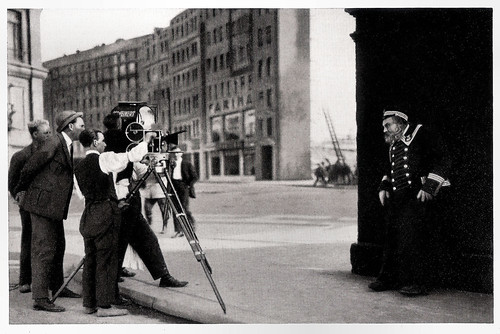
German collectors card by Ross Verlag in the series Vom Werden Deutscher Filmkunst - Der Stumme Film, picture, no, 160, Group 43. Photo: Ufa. Friedrich Wilhelm Murnau (left with hat) and Emil Jannings (right) at the set of Der letzte Mann/The Last Laugh (Friedrich Wilhelm Murnau, 1924). Caption: Der letzte Mann wird gefilmt, mit feststehendem Kamerastativ. (The Last Laugh is filmed, with a fixed camera).

German collectors card by Ross Verlag in the series Vom Werden Deutscher Filmkunst - Der Stumme Film, no. 171. Photo: Ufa. Gösta Ekman as the old Faust in Faust, Eine deutsche Volkssage/Faust (Friedrich Wilhelm Murnau, 1926).
Der brennende Acker (1922)
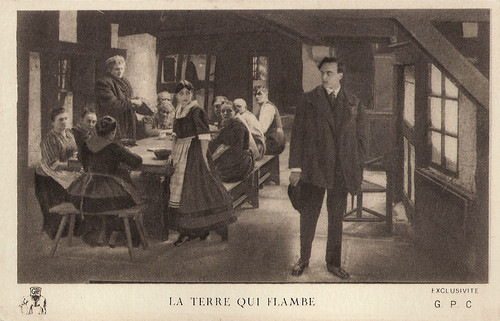
French postcard by Edition de la Cinématographie Française, Paris. Photo: G.P.C. Publicity still for Der brennende Acker/Burning Soil/La terre qui flambe (Friedrich Wilhelm Murnau, 1922). At the farm of the Rog family. The housemaid Maria (Grete Diercks) eyes Johannes Rog (Vladimir Gajdarov), but he is only interested in money.
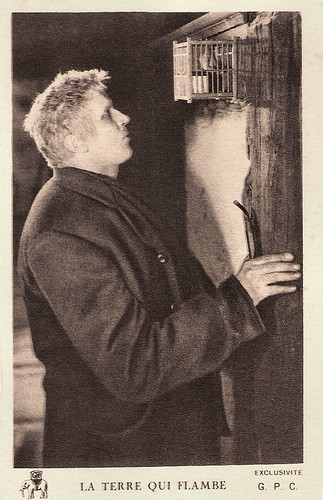
French postcard by Edition de la Cinématographie Française, Paris. Photo: G.P.C. Publicity still for Der brennende Acker/Burning Soil/La terre qui flambe (Friedrich Wilhelm Murnau, 1922) with Eugen Klöpfer. Maria works in the household of Peter Rog (Eugen Klopfer) and his father. Peter is in love with her and wants to marry her, but she instead loves his younger brother Johannes.
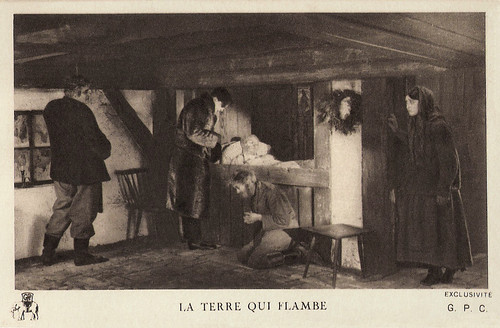
French postcard by Edition de la Cinématographie Française, Paris. Photo: G.P.C. Publicity still for Der brennende Acker/Burning Soil/La terre qui flambe (Friedrich Wilhelm Murnau, 1922). Johannes Rog (Vladimir Gajdarov) arrives too late at the deathbed of his father (Werner Krauss), while, left, his brother Peter (Eugen Klöpfer), and right, the maid Maria (Grete Diercks), look on.
In 1919, Friedrich Wilhelm Murnau began working in film. His first feature film, Der Knabe in Blau/The Boy in Blue (1919), based on motifs from the painting 'The Blue Boy' by Thomas Gainsborough, is lost, as are some of his later films. The film Der Bucklige und die Tänzerin/The Hunchback and the Dancer (1920) marked the beginning of a highly fruitful collaboration with screenwriter Carl Mayer, who subsequently wrote the scripts for six more of Murnau's films.
Until 1978, the drama Der brennende Acker/Burning Soil (1922) only survived as the three final reels. In 1978 film historian Vittorio Martinelli identified an almost complete coloured nitrate print of the film in the collection of the Cineteca Italiana in Milan. It formerly belonged to the collection of an Italian priest who had regularly screened old films in psychiatric clinics. After many years of research and restoration, the restored print was first presented in 1993.
When the old farmer Rog (Werner Krauss) dies, his son Johannes (Vladimir Gajdarov), coming from the city, does not make it to his deathbed in time. After Rog's death, his other son Peter (Eugen Klöpfer) takes over the farm.
Johannes, who does not consider himself suitable for work in the countryside, becomes a secretary to Count Rudenburg. Johannes is interested in the latter's daughter Gerda, who had arranged the job for him, but when he learns that a source of petroleum is suspected under the "Teufelsacker" (The Devil's acre) - a barren piece of land that Rudenburg had bequeathed to his second wife Helga in his will - he turns his attention to it.
Murnau's most famous film from this period is Nosferatu – Eine Symphonie des Grauens (1922) with Max Schreck in the title role, a film adaptation of Bram Stoker's 'Dracula', but which had to be renamed due to licensing problems.
Die Finanzen des Großherzogs (1924)

Yugoslavian postcard by Jos. Caklovic, Zagreb, no. 37. Photo: Balkan Film, Zagreb. Alfred Abel in Die Finanzen des Großherzogs (F. W. Murnau, 1924). Collection: Didier Hanson.
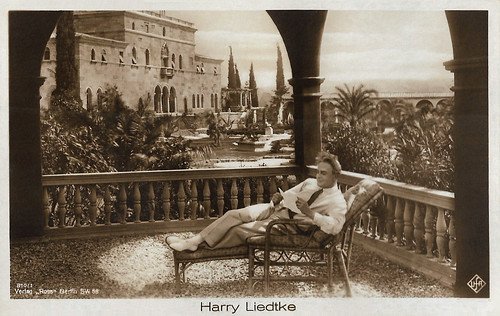
German postcard by Ross Verlag, no. 810/1. Ufa. Harry Liedtke in Die Finanzen des Großherzogs/The Grand Duke's Finances (F. W. Murnau, 1924).
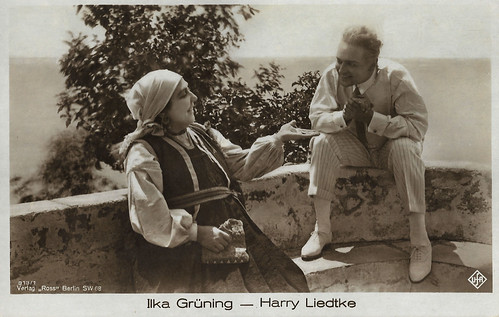
German postcard by Ross Verlag, Berlin, no. 813/1. Photo: Ufa. Ilka Grüning and Harry Liedtke in Die Finanzen des Großherzogs/The Grand Duke's Finances (F. W. Murnau, 1924).
Murnau followed with another masterpiece, the romantic fantasy Phantom (1922) starring Alfred Abel, Grete Diercks and Lil Dagover. Phantom is an example of a German Expressionist film and has a surreal, dreamlike quality.
Then followed a little gem, Die Finanzen des Großherzogs/The Grand Duke's Finances (1924). It is one of the rare comedies directed by F. W. Murnau. Harry Liedtke is the Grand Duke of Abacco who is heir to a small and heavily indebted Mediterranean island.
The Grand Duke is trying to hide from usurer Marcowitz who demands debt repayment. One hope to improve the situation would be a wedding with the Russian Grand Duchess Olga (Mady Christians) who sent him a letter saying she is determined to marry him despite not knowing him and against the opposition of her brother the Crown Prince of Russia.
Die Finanzen des Großherzogs/The Grand Duke's Finances is based on the eponymous novel by Swedish author Frank Heller adapted by Thea von Harbou. It was shot from May to August 1923 at Ufa's Tempelhof Studios in Berlin, on the sets built by Rochus Gliese and Erich Czerwonski. The on-location scenes were shot on the Adriatic coast in Split, Kotor, Zadar and Rab.
Der letzte Mann (1924)
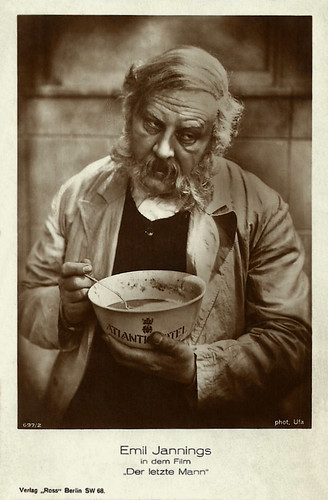
German postcard by Ross Verlag, no. 697/2. Photo: Ufa. Emil Jannings in Der letzte Mann/The Last Laugh (1924).
F.W. Murnau was now at the height of his film career in Germany and had high ambitions for his first film with Ufa. He stated that "All our efforts must be directed towards abstracting everything that isn't the true domain of the cinema. Everything that is trivial and acquired from other sources, all the tricks, devices and cliches inherited from the stage and from books."
His film, Der letzte Mann/The Last Laugh (1924) was based on a screenplay written by Carl Mayer and stars the great Emil Jannings and Maly Delschaft. Jannings plays a proud hotel doorman who loses his self-esteem and that of others when he is reduced to a toilet man, working in the basement of the hotel.
Der letzte Mann/The Last Laugh is a cinematic example of the Kammerspielfilm or "chamber-drama" genre, which follows the style of short, sparse plays of lower middle-class life that emphasized the psychology of the characters rather than the sets and action. The film famously uses no intertitles that characterize most silent films, in the belief that the visuals themselves should carry most of the meaning.
Cinematographer Karl Freund used elaborate camera movements for the film, a technique later called "entfesselte Kamera" (unchained camera). In one scene a camera was strapped to Freund's chest as he rode a bicycle into an elevator and onto the street below. In another scene, a camera is sent down a wire from a window to the street below and later reversed in editing.
The moving of the location of the camera, blurring of a part of the screen, focusing and defocusing, combined with using different angles, contributed to creating new perspectives and impressions of the viewers. The montage that was used in putting the scenes together was also pioneering: Murnau's technique was to use a smooth and rapid cutting in the initial scenes followed by jarred cutting in the scenes where the doorman becomes humiliated. A combination of distortion and overlapping images was used in the scenes illustrating the private vision of the drunk doorman. The cameramen provided enhancements to Jannings's creative use of body language by using close-ups and camera angles that encouraged the viewer to see the events from the doorman's perspective.
Tartüff (1925)

Dutch poster by Frans Bosen for Tartüff/Tartuffe (F.W. Murnau, 1925) starring Emil Jannings.
Friedrich Wilhelm Murnau based his drama Tartüff (1925) on the 1664 social comedy 'Tartuffe ou L'Imposteur' by Molière, but set in the present day.
A wealthy old man (Hermann Picha) is cared for by his housekeeper (Rosa Valetti). Since she is after his fortune, she persistently tries to convince him to include her in the will instead of his grandson. Through intrigue, she succeeds. In order to get her hands on the inheritance, she then begins to slowly poison the old man.
The grandson (André Mattoni) becomes suspicious but does not approach his grandfather to warn him at first. Now it turns out that his choice of profession as an actor is an advantage. He disguises himself as the operator of a travelling cinema and drives up in front of his grandfather's house. At first, the housekeeper wants to turn him away, but then she lets herself be persuaded by his charm to let him perform a film in the house.
The film shown is Tartüff, a film whose story is about a hypocrite (Emil Jannings) and the all-too-casual belief in him. The hypocrite in the film is exposed and so is the housekeeper after the screening: she is thrown out and grandfather and grandson are in each other's arms. According to the film, hypocrites can therefore also be called tartuffees.
In retrospective reviews, critics commented on the film's mise-en-scene and praised the performances. Several critics noted the rarity of a comedy directed by Murnau, who was famous for his expressionist dramas. Its humorous storyline and the happy ending have rendered it a minor work in Murnau's filmography and have led film critic Jonathan Rosenbaum to call it "underrated".
Faust (1926)

German postcard by Ross Verlag, no. 62/2. Photo: Parufamet / Ufa. Emil Jannings as Mephisto and Yvette Guilbert as Marthe in Faust (F.W. Murnau, 1926).
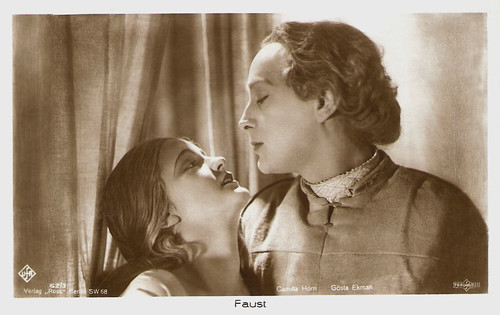
German postcard by Ross Verlag, no. 62/3. Photo: Parufamet. Gösta Ekman and Camilla Horn in Faust (1926).

German postcard by Ross Verlag, no. 66/7. Photo: Ufa. Camilla Horn and Frieda Richard in Faust (Friedrich Wilhelm Murnau, 1926).
Faust – Eine deutsche Volkssage/Faust – A German Folktale (1926) was Murnau's final German film, produced by Ufa, and starring Gösta Ekman as Faust, Emil Jannings as Mephisto, Camilla Horn as Gretchen/Marguerite, Frida Richard as her mother, Wilhelm Dieterle as her brother and Yvette Guilbert as Marthe Schwerdtlein, her aunt.
The demon Mephisto has a bet with an Archangel that he can corrupt a righteous man's soul and destroy in him what is divine. If he succeeds, the Devil will win dominion over the earth. The Devil delivers a plague to the village where Faust, an elderly alchemist, lives. Though he prays to stop the death and starvation, nothing happens. Disheartened, Faust throws his alchemy books in the fire, and then the Bible too. One book opens, showing how to have power and glory by making a pact with the Devil. Faust then makes a deal with Mephisto, who gives Faust back his youth and offers him earthly pleasures and a kingdom, in return for his immortal soul.
Murnau's film draws on older traditions of the legendary tale of Faust as well as on Goethe's classic 1808 version. Ufa wanted Ludwig Berger to direct Faust, as Murnau was engaged with Variété/Variety. Murnau pressured producer Erich Pommer and, backed by Emil Jannings, eventually persuaded Pommer to let him direct the film.
Directly afterwards Friedrich Wilhelm Murnau moved to the US under contract to William Fox. When Faust – Eine deutsche Volkssage/Faust – A German Folktale premiered in the Ufa-Palast am Zoo in Berlin, Murnau was already shooting in Hollywood. Faust seriously affected studio shooting and special effects techniques. Murnau uses two cameras, both filming multiple shots; many scenes were filmed time and again. As an example, a short sequence of the contract being written on parchment in fire took an entire day to film.
Faust – Eine deutsche Volkssage/Faust – A German Folktale has been praised for its special effects and is regarded as an example of German Expressionist film. Murnau's Faust was the most technically elaborate and expensive production undertaken by Ufa until it was surpassed by Metropolis the following year. Filming took six months, at a cost of 2 million marks (only half was recovered at the box office). A 2006 review in The New York Times called it "one of the most astonishing visual experiences the silent cinema has to offer."
Sunrise (1927)
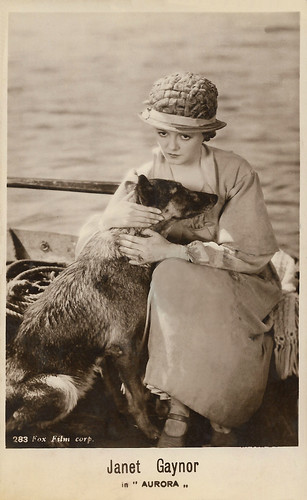
Italian postcard by G. B. Falci Editore, Milano, no. 283. Photo: Fox Film. Janet Gaynor in Sunrise (F.W. Murnau, 1927).

French postcard by CAF, Lisonne, no. 205. George O'Brien in Sunrise (F.W. Murnau, 1927).
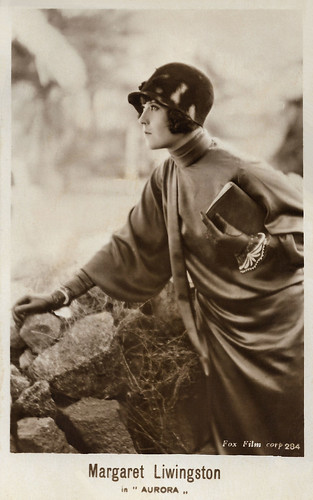
Italian postcard by G. B. Falci Editore, Milano, no. 284. Photo: Fox Film. Margaret Livingston in Sunrise (F.W. Murnau, 1927). The last name is misspelt as Liwingston.
Friedrich Wilhelm Murnau's first film in the United State was the romantic drama Sunrise/Sunrise: A Song of Two Humans (1927) starring George O'Brien and Janet Gaynor. The plot is based on Hermann Sudermann's story 'Die Reise nach Tilsit' (The Journey to Tilsit).
A vacationing Woman from the City (Margaret Livingston) lingers in a lakeside town for weeks. After dark, she goes to a farmhouse where the Man (George O'Brien) and the Wife (Janet Gaynor) live with their child. She whistles from the fence outside. The Man is torn but finally departs, leaving his wife with the memories of better times when they were deeply in love.
The man and woman meet in the moonlight and kiss passionately. She wants him to sell his farm—which has not done well recently—to join her in the city. When she suggests that he solve the problem of his wife by drowning her, he throttles her violently, but even that dissolves in a passionate embrace. The Woman gathers bundles of reeds so that when the boat is overturned, the Man can stay afloat.
The Wife suspects nothing when her husband suggests going on an outing, but when they set off across the lake, she soon grows suspicious. He prepares to throw her overboard, but when she pleads for his mercy, he realizes he cannot do it. He rows frantically for shore, and when the boat reaches land, the Wife flees...
Murnau chose to use the then-new Fox Movietone sound-on-film system, making Sunrise one of the first feature films with a synchronized musical score and sound effects soundtrack. The film incorporated Charles Gounod's 1872 composition 'Funeral March of a Marionette', which was later used as the theme for the television series Alfred Hitchcock Presents (1955–1965). Frédéric Chopin's 'A minor prelude' also features prominently in orchestral arrangement.
Upon its release, the film received excellent reviews and won three Oscars. Sunrise won the Academy Award for Unique and Artistic Picture at the 1st Academy Awards in 1929. Janet Gaynor won the first Academy Award for Best Actress in a Leading Role for her performance in the film and also for her performances in 7th Heaven (1927) and Street Angel (1928). But Sunrise became a flop at the box office.
Sunrise's legacy has endured, and it is now widely considered a masterpiece and one of the greatest films ever made. In 2012, Sunrise was ranked fifth among the best films of all time in a poll of film critics by Sight & Sound magazine. The French film magazine Cahiers du cinéma listed it in fourth place in 2008.
4 Devils (1928)

Italian postcard by G.B. Falci Editore, Milano, no. 711 Photo: Charles Munn Autrey / Fox. Charles Morton, Janet Gaynor, Nancy Drexel, and Barry Norton in 4 Devils (Friedrich Wilhelm Murnau, 1928). 4 Devils is one of the most famous 'lost' films.
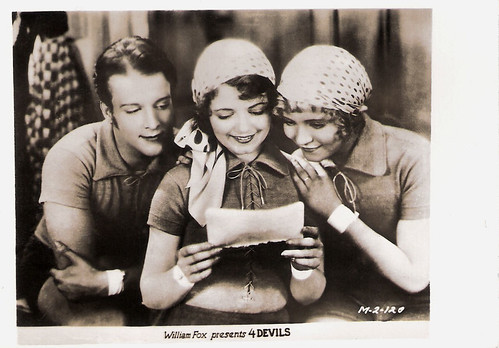
Dutch postcard. Photo: Fox. Publicity still for 4 Devils (F.W. Murnau, 1928) with Barry Norton, Janet Gaynor and Nancy Drexel.
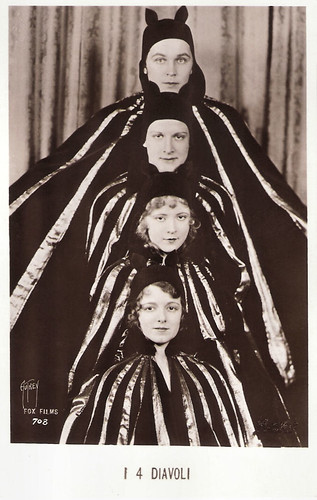
Italian postcard by G.B. Falci Editore, Milano, no. 708. Photo: Max Munn Autrey / Fox. Janet Gaynor, Nancy Drexel, Barry Norton and Charles Morton in 4 Devils (Friedrich Wilhelm Murnau, 1928).
When Sunrise did not quite meet commercial expectations, and because of the increasingly difficult economic situation of the Fox company and the situation in Hollywood on the threshold of the talkies, Friedrich Wilhelm Murnau had to accept increasing interference in his artistic concept in his following films; in the case of the film City Girl, he was even replaced as director and a sound version was subsequently produced without his influence.
4 Devils/Four Devils (1928), the film Murnau made in between Sunrise and City Girl was based on the story 'De Fire Djævle' by Danish writer Herman Bang. An old clown takes in the four children Charles, Adolf, Marion and Louise to protect them from the brutal circus owner who is their guardian. He raises them and trains them to be acrobats. The years pass and they become successful trapeze artists who call themselves the "Four Devils". Charles and Marion are now a couple. But when they perform at the Cirque Olympia in Paris, Charles gets involved with a beautiful stranger.
Mordaunt Hall of the New York Times praised Murnau's work for keeping the interest in the film from the first shot to the last. Not only are the actors directed with unmatched skill, but the camera work is smooth and seductive. Today, the film is considered lost. The original negative was destroyed in a fire and Fox apparently did nothing to secure the film material that remained intact. In 1948, the last 35 mm print was handed over to actress Mary Duncan. Nothing is known about the whereabouts of the print.
Disappointed by the constraints of Hollywood, F.W. Murnau terminated his contract with Fox in 1929. After an unsuccessful attempt to do business with Ufa again in Berlin, he bought a sailing yacht, determined to make his next film on his own according to his own ideas, and went to Tahiti to shoot the film Tabu/Taboo with the director and documentary filmmaker Robert J. Flaherty.
During the shooting, there were considerable difficulties with the film company financing the shooting costs. Eventually, Murnau parted ways with Flaherty, who had stronger documentary ambitions and produced the film at his own expense. Shot on the island of Bora Bora exclusively with local amateur actors, the film became a stylistic mixture of documentary and melodrama. The distribution of the film, financed by Murnau himself, for which he had spent his entire fortune and incurred heavy debts, was taken over by the company Paramount, which was so impressed by the film that it offered Murnau a ten-year contract.
Murnau did not live to see the premiere of Tabu/Taboo. On 11 March 1931, shortly before a planned promotional tour through Europe, Murnau let his servant, the 14-year-old Filipino Garcia Stevenson, take the wheel of his rental car on the coastal road southeast of Santa Barbara (California). As a result of excessive speed, the servant lost control of the vehicle, which plunged down a ten-metre embankment, hitting the back of Murnau's head against a utility pole. While the other occupants of the vehicle - in addition to Stevenson, the actual chauffeur and Murnau's sheepdog - remained almost uninjured, Murnau died in hospital the following night. Only eleven people attended his funeral on 19 March, including Greta Garbo.
Sources: Wikipedia (German, Italian and English), and IMDb.
This post was last updated on 3 July 2022.
No comments:
Post a Comment